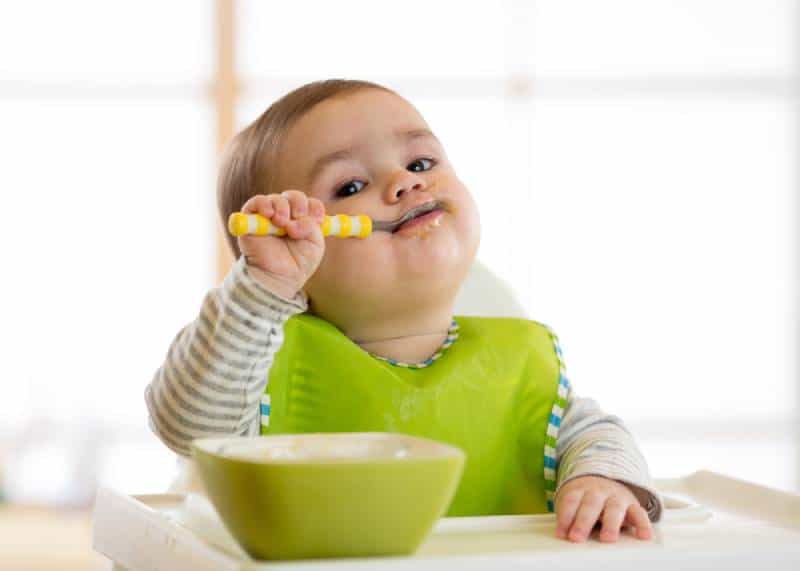Here’s a unique look into how to help your baby start solid foods all on their own, all while being informed on the best baby led weaning foods there are.
Now, you might be wondering what exactly baby led weaning is in the first place. Simple – it means skipping purees altogether and going straight into finger foods by basically implementing self-feeding for your little one.
Weaning your baby from breast milk can be a bit messy.
Trying to get him to eat those veggies and open his mouth, all while trying to enjoy a family meal, can be too much for anyone.
That’s why some moms resort to BLW (baby led weaning).
It’s so simple – the baby eats what he wants and how he wants, which can make the whole experience easier for everyone.
Here’s all you need to know about starter foods for BLW, and how this unique approach can be beneficial in more ways than one!
Why Should You Start Baby Led Weaning?

After your baby is 6 months of age and older, you’re ready to consider this really interesting approach to eating solids on his own.
Your little one needs to be capable of self-feeding which is why it’s so crucial to make sure he’s the right age for that.
The whole point is to teach your young one to eat healthily as soon as possible, which will be easier when he has some sort of control over what goes into his mouth.
Additionally, this way, your baby will put as much baby food as he needs, without you having to worry if you’ve overdone it.
The benefits of BLW are amazing.
It is believed to enhance hand-eye coordination and motor skills, it helps babies learn how to chew properly, and it is all about acquiring healthy eating habits.
Babies who are introduced to BLW are exposed to a variety of different tastes and textures, unlike when they’re being fed solely purees.
On top of that, this might encourage them to develop a good sense of what they like and don’t like much earlier than one would expect.
Oh, and here’s another amazing benefit.
Baby led weaning is much less likely to cause weight gain in children the way spoon-feeding does. Talk about a fantastic benefit, right?
This approach can easily educate your baby on how he, too, can enjoy the same meals as the whole family without all the fuss and frustration that often happens during mealtime with a baby.
When Is It Okay To Start Baby Led Weaning?
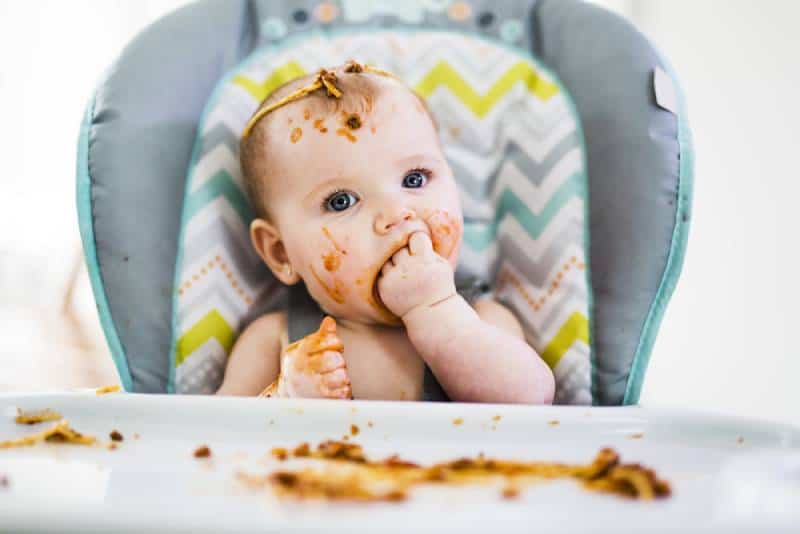
According to experts at the American Academy of Pediatrics (AAP), you can’t go wrong if you start when your baby is 6 months old.
Why, you may wonder?
Because by that age, most young ones have mastered the art of sitting on their own and reaching for things they’re interested in, which is the whole premise here.
So first, make sure that your baby can sit on his own and hold his head up without your help.
Observe him while you’re eating, as you’ll notice his interest in your food (which is a good sign).
Also, he needs to be over the tongue-thrust reflex, that which makes babies spit out unknown foods from their mouths.
Another sign that your baby is ready to bypass soft foods and go straight to finger foods is if he can chew and move the food in his mouth, instead of just swallowing or spitting it out.
Here’s a pro tip: Opt for a quality high chair that allows your child to sit up straight comfortably and move his hands around with no problems.
How To Choose The Best First Foods For Baby Led Weaning?

All moms have their own way of introducing their child to BLW, and just because something works for your friend, it doesn’t have to work for you.
But that’s okay!
I’m here to help you figure out the best way to incorporate this approach into your lifestyle and help you see it from every point of view.
You may also consult with your pediatrician in case you’re hesitant, but it all comes down to you.
Always try to feed your little one whole foods as opposed to processed ones and be mindful of when you’re introducing him to potential allergens.
Here are the three most important components you should take into consideration during baby led weaning:
• The size of the food matters
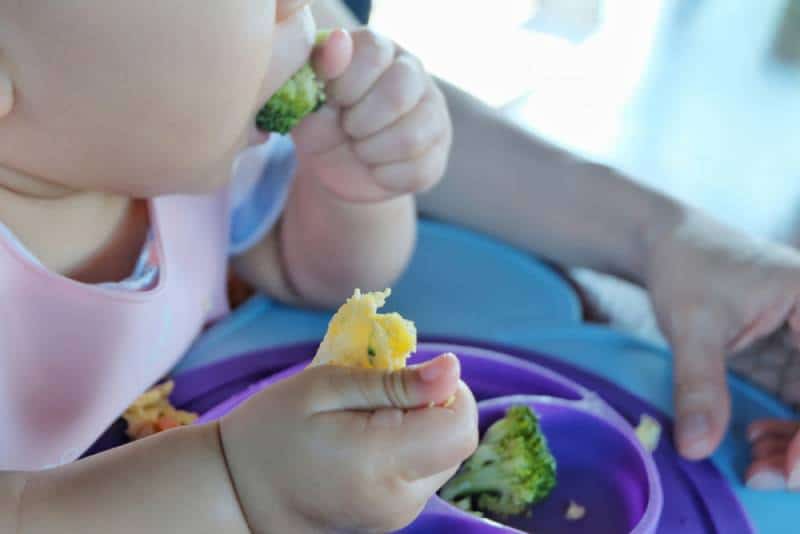
Your child needs to be able to pick up the food you serve him.
If he can’t, this whole thing doesn’t make much sense, does it? Luckily, after they turn 6 months of age, most babies’ pincer grasp is mastered.
So if you’re adamant to offer him healthy foods like avocados, sweet potatoes, or cauliflower, make sure to cut the foods for baby led weaning into small pieces, but not so small that they’re a choking hazard (like blueberry or green beans).
• The food needs to be on the softer side
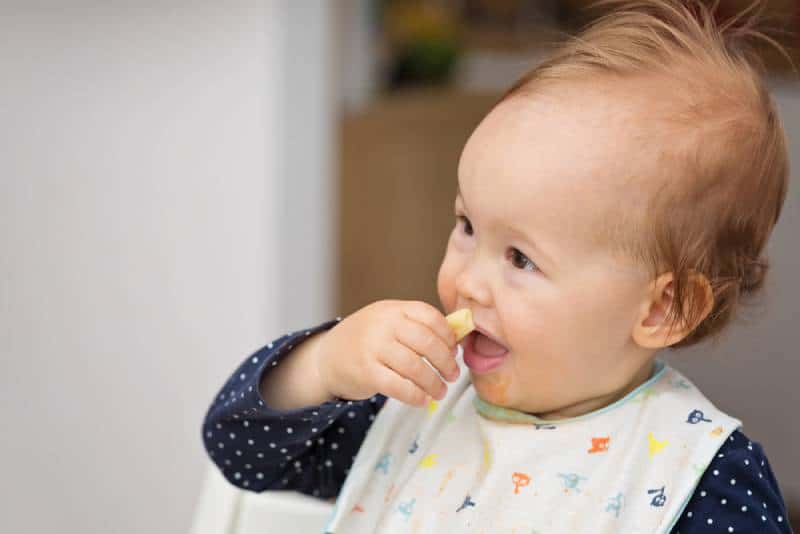
The texture is really important as well. But how do you know when it’s ideal for the baby? Really simple!
Try to mash the food with your thumb and your index finger first. If you’ve succeeded without struggle, you’re good to go.
A cautionary note, though: If you’re giving your child fruits and vegetables, make sure to properly clean them first and be mindful of any possible food allergies your baby might have.
• Make it as easy for your baby as possible
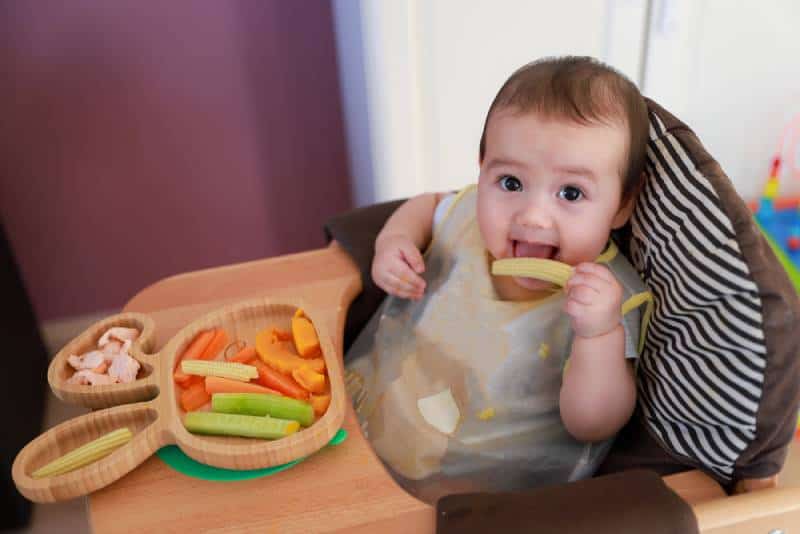
What does this mean?
There are foods your baby might find difficult to hold (some are slippery like bananas or avocado) so leave some peel on for him to hold on to.
A crinkle cutter can also be extremely useful with certain foods.
Make the process easy for your little one, as introducing new foods in his first year can be a draining process.
So the easier you make it on him, the more likely for it to stick.
Now, let’s look at some acceptable baby led weaning foods that your dietitian would most definitely approve of.
• When it comes to vegetables, here are your best bets:
Broccoli, zucchini, radishes, peppers, carrots, peas, corn, butternut squash, eggplant, potatoes, and cucumber.
• When it comes to fruits, here are your top choices:
Apples, blueberries, plums, banana, kiwi, pineapple, honeydew, peaches, mango, oranges, watermelon, banana, avocado, and grapes.
• Here are some healthy high protein foods:
Black beans, ricotta, chicken, hard-boiled eggs, turkey, salmon, beef, meatballs, lentils, shrimp, sausage, chickpeas, tofu, hummus, feta, and nut butter.
• And finally, here are some acceptable carbs:
Rice balls, waffles, pancakes, barley, quinoa, toast, pasta, millet, couscous, and farro.
My pro tip is to find a great, dependable baby led weaning cookbook and find the best combo for all of these food types.
Plus you’ll probably stumble upon some cool baby led weaning recipes that you probably wouldn’t think of yourself.
For some, mixing purees with baby led weaning is a winner; for others, it’s all about the finger foods.
Don’t be discouraged to try any of these. It’s all about trial and error (nobody gets it right the first time around.)
Useful Tips For Successful Baby Led Weaning
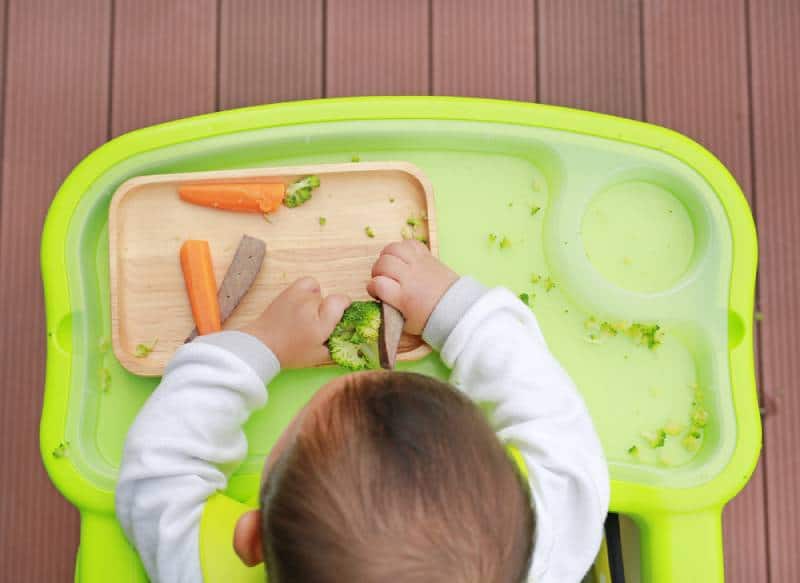
First and foremost, it’s important to truly understand what gag reflex is.
Most moms go into panic mode the moment they see their baby gagging, but most of the time, it’s completely safe.
Choking is one thing, but gagging means that your young one is merely learning how to enjoy the new foods and getting accustomed to the taste.
Give him time to figure it all out.
I know it looks scary, but learn the difference between choking and gag reflex – it’ll save you a lot of nerves, I promise.
Be sure that your baby is truly ready to skip purees and jump into solid foods. Consult with your pediatrician, dietitian, or your mom.
You can never ask too many questions when it comes to your baby’s well-being.
Sit next to your baby as he’s exploring baby led weaning and try to make it as fun as you can.
You can also get him a great high chair so that he can sit straight with ease and move his hands freely.
Manage your expectations and let your baby have a go at it.
This is about your little one, not you. Let him make a mess, explore, and discover if he likes the pureed veggies or not.
You can also opt for a combination of BLW and spoon-feeding for the first few times.
For some of my friends, that helped a lot in the process of getting their little ones to truly get a hang of the whole thing.
Don’t overdo it. Personally, I’d go for one new type of food every 2-3 days.
That way, your baby won’t be overwhelmed with an array of different tastes and will have time to get used to each one.
Moreover, it’s a safe approach to pinpoint any potential allergens.
Foods To Steer Clear Of When Starting BLW

There are certain foods that you should in no way put on your baby’s plate. Here are some examples of what to avoid:
• Don’t add salt into any food you present your baby with. Too much salt is unhealthy even for adults, let alone babies.
• Be mindful of foods that are possible choking hazards. Anything too tiny that can be easily broken and end up stuck in your young one’s throat is a no-go (plus, always remain next to him to react on time if something happens).
• Your baby won’t appreciate anything that is too sticky, which also goes for foods that are overly crunchy or hard. Be mindful of his delicate (and toothless!) palate.
• My pediatrician told me to steer clear of cow’s milk during this approach, so I’d encourage you to do the same.
• You probably already knew this, but don’t give your young one honey – it’s not appropriate for such small babies yet.
• I’ve already mentioned that slippery foods are really impractical for babies. But this issue can actually be bridged if you leave some of the peel for him to hold on to.
FAQ Regarding Baby Led Weaning
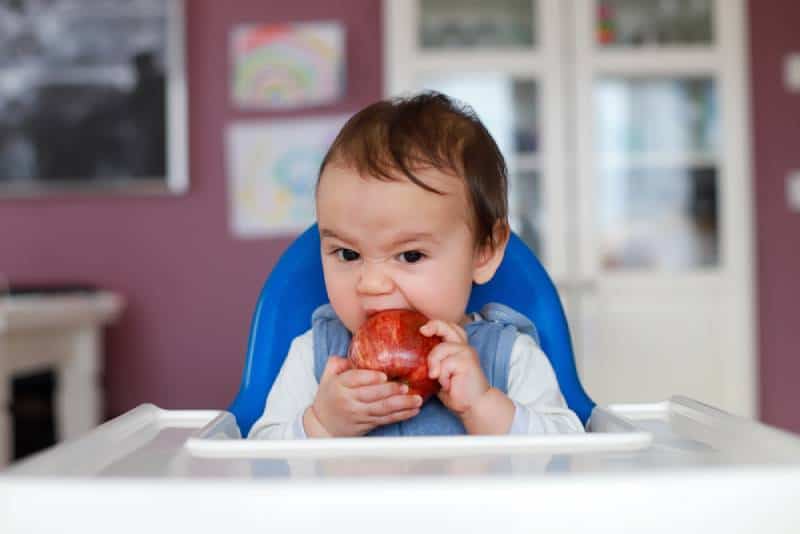
Here are some common questions I’ve personally been asked and also wondered about myself when trying out this feeding approach.
• Does baby led weaning work for babies with no teeth?
Absolutely, yes.
You might not have known this, but front teeth don’t actually make a difference when it comes to chewing.
It’s all about gums. It’s perfectly safe to try this approach even if your baby has zero teeth.
• Are babies’ needs completely met with this technique?
To be perfectly honest, in the initial stages, no, there won’t be that much eating. Your baby will likely just taste the food and play with it.
His main source of nutrition at this stage will still be breast milk (or formula).
So don’t expect miracles right from the get-go.
But be certain that within the first few months, it’ll slowly start changing and the transition to BLW will become a much more prominent aspect of his life.
• Is it okay to mix purees and baby led weaning?
It is! It’s actually a really good idea that I know for a fact a few people do, and with great success.
It’s actually pretty amazing for your baby as it introduces him to more tastes and textures.
• Should you introduce possible allergens into your baby’s diet?
This would include eggs, shellfish, soybeans, and/or peanuts.
Well, if your family history is all-clear when it comes to allergies and you’re certain your baby doesn’t have any, I’d advise you to give it a go right around the time he starts eating solids.
Contrary to popular belief, giving your child allergenic foods is actually beneficial for his overall health, purported to protect your child from developing any allergies.
But always err on the safe side and definitely consult with your pediatrician just to have peace of mind.
Final Thoughts
There is an array of amazingly nutritious baby led weaning foods that can make this entire process a breeze.
The most important thing for you as a parent is to manage your expectations.
Don’t expect miracles on the first try, as babies need time to get adjusted to their new feeding approach.
I’ve shared with you some of the foolproof tips that worked wonders for me, and I genuinely hope they can bring you some heartsease and success as well.
Follow your baby’s lead and let him show you what he needs.
That’s the whole beauty of BLW. Exploring, discovering, and learning to enjoy the process, no matter how messy it gets.
Plus, it’s really good for your young one’s hand-eye coordination, motor skills, and adaptation to a healthier lifestyle.
So, when you really think about it, what’s not to love?
References: American Academy of Pediatrics – “Baby-led weaning: a good idea or not?”, September 27, 2016.
READ NEXT: 15 Best Veggies And Fruits For Toddlers For A Healthy Diet
Like this post? Please share or pin it for later. You can also stay in the loop and follow us on Facebook, Instagram or Pinterest.

This post contains affiliate links. Please see our full disclosure for more info.

